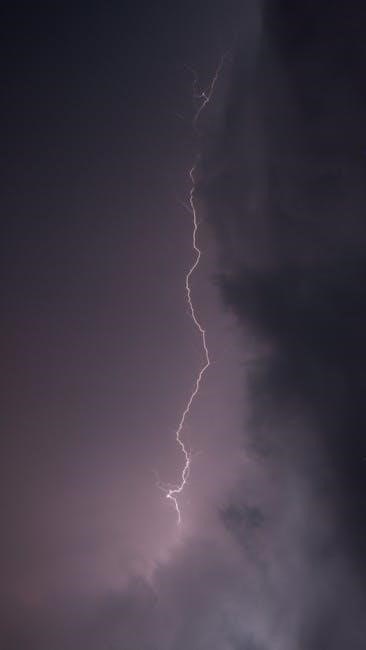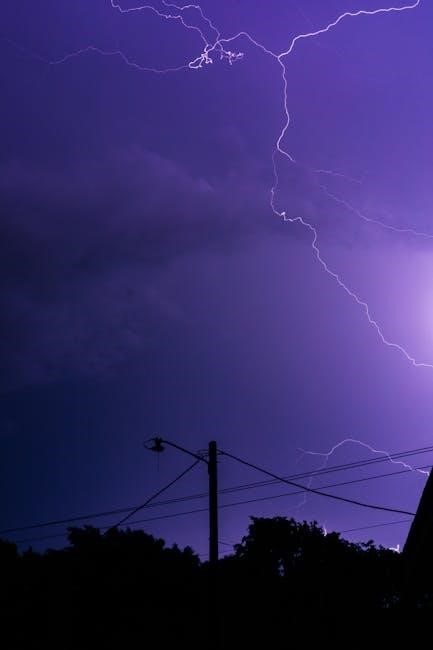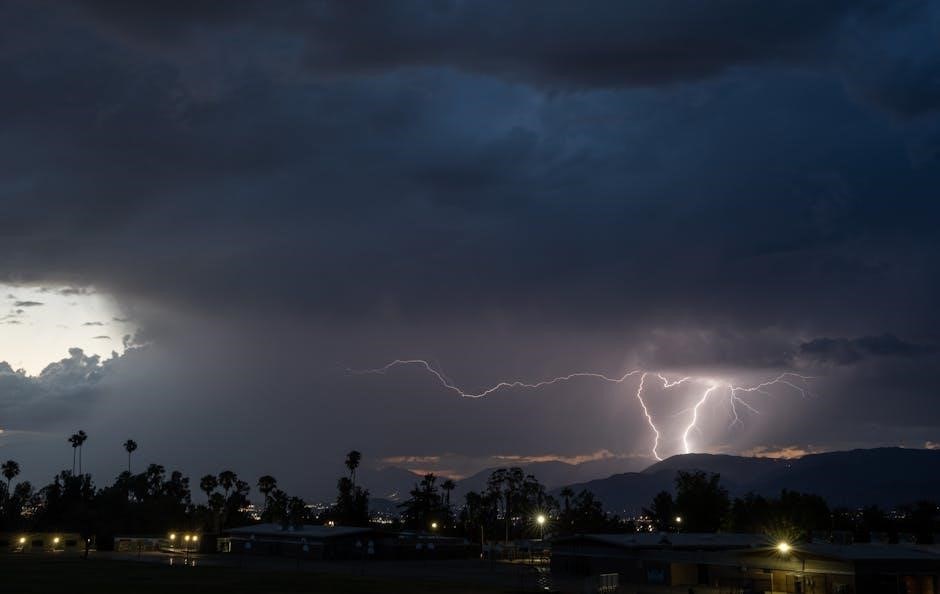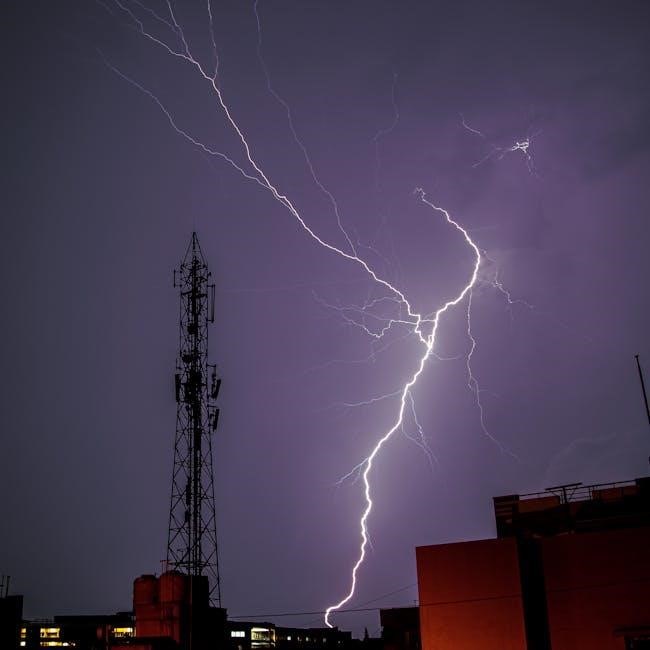The lightning bolt warning light on your Dodge Ram indicates issues with the electronic throttle control system, signaling potential problems that need immediate attention for safe driving.
1.1 Overview of the Lightning Bolt Symbol
The lightning bolt symbol on your Dodge Ram’s dashboard is a warning light that signals issues with the electronic throttle control system. This icon, often depicted as a stylized lightning bolt, indicates problems with the vehicle’s throttle system, which is responsible for regulating engine power. Unlike older vehicles with mechanical throttle cables, modern systems rely on electronic controls, making this warning a critical indicator of potential driveability issues that require prompt attention for safe operation.
1.2 Importance of Understanding Dashboard Warning Lights
Understanding dashboard warning lights, like the lightning bolt symbol, is crucial for vehicle maintenance and safety. These indicators provide early alerts about potential issues, such as problems with the electronic throttle control system, allowing drivers to address them before they escalate. Ignoring these warnings can lead to reduced performance, increased repair costs, or even safety hazards. Being informed enables timely actions, helping to prevent breakdowns and ensure reliable vehicle operation. Regular monitoring and prompt responses are key to maintaining your Dodge Ram’s health and longevity.
What Does the Lightning Bolt Symbol Mean on a Dodge Ram?
The lightning bolt symbol on a Dodge Ram indicates a problem with the electronic throttle control system, alerting drivers to potential issues that require immediate attention.
2.1 Electronic Throttle Control System Overview
The Electronic Throttle Control (ETC) system in Dodge Ram vehicles replaces traditional mechanical linkages with electronic sensors and actuators to manage throttle opening. This system enhances engine performance, fuel efficiency, and responsiveness by precisely controlling airflow based on driver input. The ETC communicates with the engine control module to optimize power delivery under various driving conditions, ensuring smooth acceleration and reduced emissions. However, issues in this system trigger the lightning bolt warning light, signaling potential malfunctions.
2.2 Common Issues Indicated by the Lightning Bolt
The lightning bolt warning light commonly signals problems within the Electronic Throttle Control system, such as faulty throttle position sensors, malfunctioning throttle bodies, or damaged wiring. It may also indicate issues like loss of communication between components or software glitches in the engine control module. Additionally, dirty or corroded connections can trigger the light, highlighting the need for prompt inspection and repair to maintain proper engine functionality and driver safety.

Common Causes of the Lightning Bolt Warning Light
The lightning bolt light is often triggered by issues like faulty throttle bodies, throttle position sensors, wiring problems, or software glitches in the engine control module.
3.1 Faulty Throttle Body or Throttle Position Sensor
A faulty throttle body or throttle position sensor can cause the lightning bolt warning light to illuminate. The throttle body regulates airflow to the engine, while the position sensor monitors the throttle’s angle. If either component fails, it disrupts communication between the throttle and the engine control module, leading to issues like inconsistent acceleration or engine hesitation. Regular cleaning and inspection of these components can help prevent such problems.
3.2 Issues with the Electronic Throttle Control System
Issues within the electronic throttle control system often trigger the lightning bolt warning light. This system, which replaces traditional mechanical linkages, relies on sensors and actuators to regulate throttle opening. Problems such as sensor malfunctions, wiring faults, or software glitches can disrupt communication between components. Symptoms may include erratic throttle response, reduced power, or difficulty accelerating. Addressing these issues promptly is crucial to maintaining vehicle performance and safety on the road.
3.3 Wiring or Connection Problems
Wiring or connection issues can trigger the lightning bolt warning light. Corrosion, damage, or loose connectors in the throttle control system’s wiring harness may disrupt communication between sensors and the engine control module. This can cause intermittent or permanent system malfunctions. Inspecting the wiring and connections is essential during diagnosis. Faulty wiring can mimic other issues, making it crucial to address these problems promptly to avoid further complications and ensure proper system functionality.
3.4 Software Glitches in the Engine Control Module
Software glitches in the engine control module (ECM) can activate the lightning bolt warning light. These issues may stem from outdated software, corrupted files, or unexpected system crashes. Such glitches can disrupt communication between sensors and the ECM, leading to false readings. Updating the ECM software or performing a system reset often resolves these problems. Regular software maintenance is crucial to prevent such glitches and ensure smooth operation of the electronic throttle control system in your Dodge Ram.

What to Do When the Lightning Bolt Light Appears
When the lightning bolt light appears, reduce speed, avoid sudden acceleration, and check for any immediate issues. Use a scan tool to retrieve fault codes for guidance.
4.1 Immediate Steps to Take
When the lightning bolt light appears, immediately reduce your speed to minimize potential damage. Avoid sudden acceleration and pull over safely if possible. Turn off the engine to prevent further issues. Do not ignore the warning, as it indicates a problem with the electronic throttle control system. Check for any obvious signs of damage or loose connections. Use a scan tool to retrieve fault codes for a better understanding of the issue. Seek professional help if the problem persists or if you are unsure how to proceed. Remember, ignoring this warning can lead to more severe complications and safety risks while driving. Always prioritize safe driving practices when such a warning light appears.
4.2 Checking for Basic Issues
Start by inspecting the throttle body for dirt or debris, as a dirty throttle body can trigger the lightning bolt light. Check the throttle position sensor and ensure all electrical connections are secure. Look for any signs of wear or damage in the wiring harness. Verify that the accelerator pedal is functioning properly and free from obstructions. If you notice any issues, address them promptly to prevent further complications. These basic checks can often resolve the problem without the need for advanced tools or professional assistance.
4.3 Using a Code Reader or Scan Tool
A code reader or scan tool is essential for identifying the specific issue causing the lightning bolt light. Connect the tool to your vehicle’s OBD-II port to retrieve error codes. These codes will point to problems such as a faulty throttle body, throttle position sensor, or issues within the electronic throttle control system. This step helps pinpoint the exact cause, saving time and money by avoiding unnecessary repairs. Always refer to your owner’s manual for compatible tools and follow the manufacturer’s instructions for accurate results.
4.4 When to Seek Professional Help
If the lightning bolt light persists after basic checks or if you encounter complex error codes, seek professional help. A certified mechanic can diagnose issues like faulty sensors, wiring problems, or software glitches. They have the expertise and tools to repair or replace components within the electronic throttle control system. Don’t hesitate to consult a professional if you’re unsure or if the issue affects your vehicle’s performance or safety.

How to Diagnose the Lightning Bolt Warning Light
Check the throttle body, sensors, and wiring for faults. Use a scan tool to retrieve error codes and inspect connections for damage or corrosion.
5.1 Tools and Equipment Needed
To diagnose the lightning bolt warning light, you’ll need a scan tool to read error codes, a multimeter for electrical checks, screwdrivers for throttle body access, and a torque wrench for proper connections. A wiring diagram of your Dodge Ram’s electronic throttle system is essential for tracing issues. Additionally, gloves and safety goggles are recommended for protection during the process. These tools will help you identify and address the root cause efficiently.
5.2 Step-by-Step Diagnostic Process
Start by connecting a scan tool to your Dodge Ram’s OBD-II port to retrieve error codes. Inspect the throttle body for dirt or damage. Use a multimeter to check wiring and sensors for connectivity issues. Test the throttle position sensor’s voltage and resistance. Clean the throttle body if necessary and retest. Clear the codes and take a test drive to see if the light returns. If issues persist, consult a professional for advanced diagnostics. Always wear gloves and safety goggles during the process.

Preventative Maintenance to Avoid the Lightning Bolt Light
Regularly clean the throttle body, inspect sensors, and check wiring connections to prevent issues with the electronic throttle control system and avoid the warning light.
6.1 Regular Throttle Body Cleaning
Regular cleaning of the throttle body helps prevent dirt and carbon buildup, which can disrupt the electronic throttle control system. Use a throttle body cleaner and a soft brush to remove debris. Avoid harsh chemicals that may damage components. Ensure the throttle body is dry before restarting the engine. Cleaning every 30,000 to 50,000 miles can help maintain optimal performance and prevent the lightning bolt warning light from appearing.
- Clean the throttle body with a specialized cleaner.
- Avoid using abrasive materials or harsh chemicals.
- Dry the area thoroughly before restarting the engine.
6.2 Checking and Replacing Worn-Out Sensors
Regularly inspecting and replacing worn-out sensors, such as the throttle position sensor (TPS) and mass airflow sensor (MAF), can prevent issues that trigger the lightning bolt warning light. Use a multimeter to test sensor resistance and voltage. If readings are out of spec, replace the sensor promptly. Dirty or malfunctioning sensors can disrupt the electronic throttle control system, leading to performance issues. Always consult a repair manual or a professional for accurate diagnosis and replacement.
- Inspect sensors for dirt, corrosion, or physical damage.
- Use a multimeter to test sensor performance.
- Replace faulty sensors with OEM or high-quality alternatives.

Common Misconceptions About the Lightning Bolt Light
Some believe the lightning bolt light indicates only throttle body issues, while others think it’s a minor problem. However, it often signifies broader system malfunctions.
7.1 Myths vs. Facts
A common myth is that the lightning bolt light only indicates a faulty throttle body, but it can also signal issues with wiring, sensors, or the entire electronic throttle system. Some drivers believe the light is not urgent, but ignoring it can lead to reduced engine performance or even stalling. While minor issues may resolve on their own, persistent illumination often requires professional diagnostics to prevent further damage.
7.2 Avoiding Unnecessary Repairs
To avoid unnecessary repairs, always start with a basic inspection and use a code reader to identify the specific issue. Cleaning the throttle body or checking wiring often resolves the problem without costly replacements. Avoid assuming the throttle body is faulty without proper diagnosis, as other components like sensors or connections may be the root cause. Addressing the issue early and correctly prevents further damage and saves money on unwarranted fixes.
Repair Costs and DIY Fixes
Repair costs vary depending on the issue, with throttle body replacements ranging from $50 to $300. DIY fixes, like cleaning the throttle body, can save money and time.
8.1 Estimated Costs for Professional Repairs
Professional repairs for the lightning bolt warning light can range from $50 to $300, depending on the issue. Throttle body replacements typically cost between $200 and $300, including labor. If the problem is with the throttle position sensor, expect to pay around $150 to $250. Wiring issues or electronic throttle control system repairs may add another $100 to $200. Labor costs generally range from $75 to $150 per hour, depending on the mechanic or dealership.
8.2 DIY Solutions for Minor Issues
For minor issues, cleaning the throttle body with a throttle cleaner can resolve the problem. Inspect sensors and connections for dirt or corrosion and clean them gently. Resetting the ETC system by disconnecting the battery for 10-15 minutes may also clear the light. Basic tools like a multimeter can help check wiring continuity. These fixes typically cost $10 to $50, saving money compared to professional repairs. Always refer to your owner’s manual for guidance.

Real-World Experiences and Owner Reviews
Dodge Ram owners have shared experiences where the lightning bolt light appeared due to throttle control issues. Many found cleaning the throttle body resolved the problem quickly.
9.1 Stories from Dodge Ram Owners
Many Dodge Ram owners have reported encountering the lightning bolt warning light, often due to issues with the electronic throttle control system. Some experienced intermittent engine performance, while others noticed a complete loss of acceleration. Several owners found success by cleaning the throttle body or replacing faulty sensors. A few cases required more extensive repairs, such as updating the engine control module software. These real-world stories highlight the importance of addressing the issue promptly to avoid further complications and ensure safe driving conditions.
9.2 Lessons Learned from Fixing the Lightning Bolt Light
Owners who addressed the lightning bolt warning light shared valuable insights. Regular maintenance, like cleaning the throttle body, can prevent issues. Staying informed about dashboard symbols and understanding basic diagnostics helps catch problems early. Prompt action is crucial to avoid costly repairs. Many emphasized the importance of using quality replacement parts and seeking professional help when needed. These lessons underscore the value of proactive care and informed decision-making to maintain vehicle reliability and performance over time.
The lightning bolt warning light serves as a critical indicator of issues within the electronic throttle control system. Addressing it promptly ensures vehicle safety and reliability, preventing costly repairs. Regular maintenance and understanding dashboard symbols are key to avoiding future problems; By staying informed and proactive, Dodge Ram owners can enjoy a smoother, trouble-free driving experience.
10.1 Summary of Key Takeaways
The lightning bolt warning light on a Dodge Ram signals issues with the electronic throttle control system, requiring prompt attention to ensure safety and prevent damage. It indicates potential problems like faulty sensors, wiring issues, or software glitches. Addressing the light early can avoid costly repairs and maintain optimal vehicle performance. Regular maintenance, such as cleaning the throttle body and checking sensors, can help prevent the light from appearing. Always use diagnostic tools or consult professionals for accurate repairs and to restore your vehicle’s reliability.
10.2 The Importance of Timely Repairs
Addressing the lightning bolt warning light promptly is crucial to prevent minor issues from escalating into major, costly repairs. Ignoring the light can lead to reduced performance, increased repair expenses, and potential safety risks. Timely action ensures your Dodge Ram operates safely and efficiently, avoiding unexpected breakdowns. Regular maintenance and quick responses to warning signs are essential for preserving your vehicle’s health and longevity. Act promptly to maintain reliability and avoid future complications.



